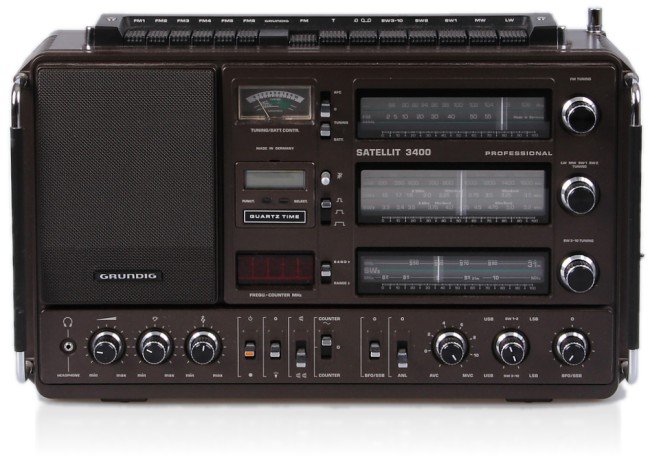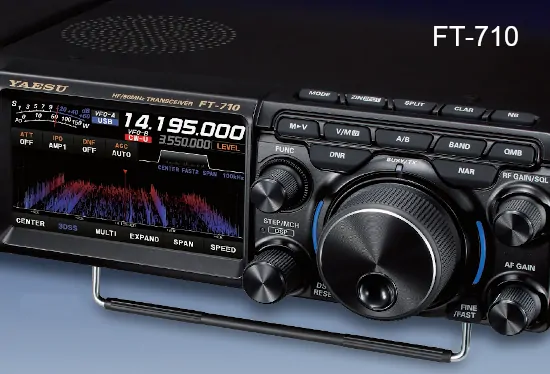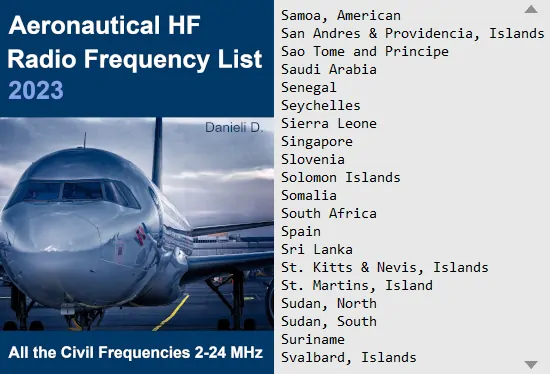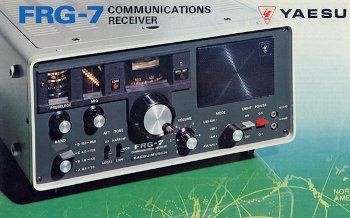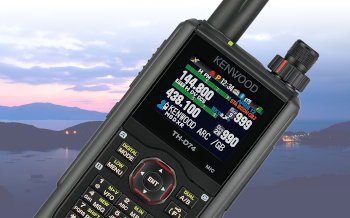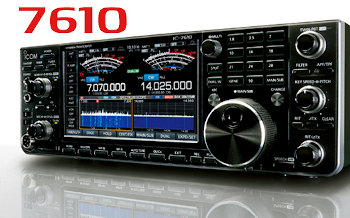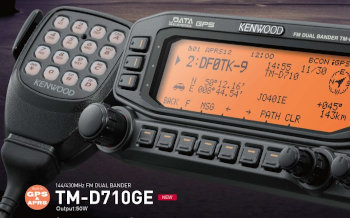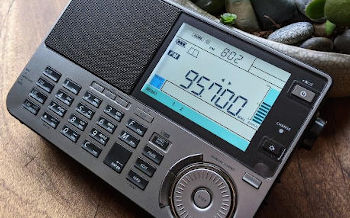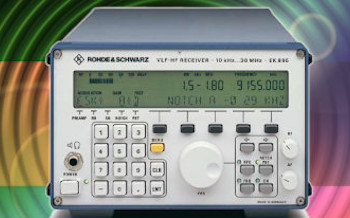
Kenwood's flagship HF/50 MHz radio. The transceiver comes equipped with dual receivers for simultaneous reception on different bands. It features narrow-band (270Hz to 15kHz) roofing filters in the main receiver in a full down-conversion configuration, +40 dBm third-order IP, amateur bands pre-selector that varies its tuning in tandem with the receiver frequency, 0.1ppm TCXO, built-in RTTY and PSK31/63 encoder and decoder. Clean 5 to 200 Watts transmit power through the 50 Volt VRF150 MOSFET final unit, high-speed automatic antenna tuner, drive output for 137 kHz band. Three Analog Devices 32-bit floating-point arithmetic DSP. Also, thanks to the dual multi-mode TFT display and panel layout, it achieves both comfortable visibility and operability. Ideated in Japan, year of introduction 2013.
Reference market : amateur-radio
TS-990S specifications
| General |
| Frequency coverage | |
|---|---|
| Receive | 0.0300 ~ 60.0000 MHz [1] |
| Transmit | 0.1357 ~ 0.1378 MHz [2] 1.8000 ~ 2.0000 MHz 1.8100 ~ 2.0000 MHz [3] 3.5000 ~ 4.0000 MHz 3.5000 ~ 3.8000 MHz [3] 5.1675 MHz 5.2500 ~ 5.4500 MHz 7.0000 ~ 7.3000 MHz 7.0000 ~ 7.2000 MHz [3] 10.1000 ~ 10.1500 MHz 14.0000 ~ 14.3500 MHz 18.0680 ~ 18.1680 MHz 21.0000 ~ 21.4500 MHz 24.8900 ~ 24.9900 MHz 28.0000 ~ 29.7000 MHz 50.0000 ~ 54.0000 MHz 50.0000 ~ 52.0000 MHz [3] |
| Mode | |
| CW / PSK / FSK (RTTY) / LSB / USB / AM / FM | |
| Tuning step | |
| 1 / 10 Hz
0.5 / 1 / 2.5 / 5 / 10 kHz (CW/SSB/FSK/PSK) 5 / 6.25 / 9 / 10 / 12.5 / 15 / 20 / 25 / 30 / 50 / 100 kHz (AM) 5 / 6.25 / 10 / 12.5 / 15 / 20 / 25 / 30 / 50 / 100 kHz (FM) 100 / 500 kHz / 1 MHz (Up/Down key) |
|
| Receiver |
| Sensitivity [4] | |
|---|---|
| CW / SSB | 0.5 uV (0.13~0.522 MHz, 10dB S/N) 4.0 uV (0.522~1.705 MHz, 10dB S/N) 0.2 uV (1.705~24.5 MHz, 10dB S/N) 0.13 uV (24.5~30 MHz, 10dB S/N) 0.13 uV (50~54 MHz, 10dB S/N) |
| PSK / FSK | 0.5 uV (0.13~0.522 MHz, 10dB S/N) 4.0 uV (0.522~1.705 MHz, 10dB S/N) 0.2 uV (1.705~24.5 MHz, 10dB S/N) 0.13 uV (24.5~30 MHz, 10dB S/N) 0.13 uV (50~54 MHz, 10dB S/N) |
| AM | 6.3 uV (0.13~0.522 MHz, 10dB S/N) 32 uV (0.522~1.705 MHz, 10dB S/N) 2.0 uV (1.705~24.5 MHz) 1.3 uV (24.5~30 MHz, 10dB S/N) 1.3 uV (50~54 MHz, 10dB S/N) |
| FM | 0.22 uV (28~30 MHz, 12 dB SINAD) 0.22 uV (50~54 MHz, 12 dB SINAD) |
| Selectivity [5] | |
| CW | > 500 Hz (-6dB)
< 1200 Hz (-60dB) |
| FSK / PSK | > 500 Hz (-6dB)
< 1200 Hz (-60dB) |
| SSB | > 2.4 KHz (-6dB)
< 4.4 KHz (-60dB) |
| AM | > 6.0 KHz (-6dB)
< 12.0 KHz (-50dB) |
| FM | > 12.0 KHz (-6dB)
< 25.0 KHz (-50dB) |
| RF preamplifiers | |
| Preamp1 | Low-gain (< 21.5 MHz) |
| Preamp2 | High-gain (> 21.5 MHz) |
| RF attenuator | |
| 6 / 12 / 18dB | |
| DR (Dynamic Range) [6] | |
| 111 dB (14.2 MHz, 20 KHz spaced signals) | |
| Blocking [6] | |
| 145 dB (14.2 MHz, 100 KHz spaced signal) | |
| IP3 (3rd order intercept point) | |
| +40 dBm (14.1 MHz, Main RX) | |
| Synthesizer phase noise | |
| -135 dB (14.1 MHz, offset 10 KHz) -148 dB typ (14.1 MHz, offset 100 KHz) |
|
| Image rejection | |
| > 70 dB (HF bands) > 60 dB (50 MHz band) |
|
| IF rejection | |
| > 70 dB | |
| Notch filter | |
| Manual | > 70 dB |
| Automatic | > 60 dB > 40 dB (multi beat) |
| NB (Noise Blanker) | |
| Two type, can be used simultaneously | |
| DNR (Digital Noise Reduction) | |
| Two type | |
| RIT (Receiver Incremental Tuning) | |
| ± 9.999KHz | |
| AGC (Automatic Gain Control) | |
| Adjustable FAST, MID, SLOW or OFF | |
| Frequency stability | |
| ± 0.1 ppm max with temperature from 0°C to +50°C | |
| IF Main receiver | |
| 1° | 8.248 MHz |
| 2° | 24 kHz 455 KHz (only FM) |
| IF Sub1 receiver [7] | |
| 1° | 11.374 MHz |
| 2° | 24 kHz |
| IF Sub2 receiver [7] | |
| 1° | 73.095 MHz |
| 2° | 10.695 MHz |
| 3° | 24 kHz 455 KHz (only FM) |
| IF roofing filter | |
| 270 / 500 Hz / 2.7 / 6 / 15 KHz (Main receiver)
500 Hz / 2.7 KHz (Sub receiver) |
|
| CW features | |
| Auto tune Semi break-in / full break-in Pitch control (300~1100 Hz) Audio peak filter (APF) Reverse mode LSB/USB |
|
| Transmitter |
| Output power [2] | |
|---|---|
| CW / FSK / PSK / SSB / FM | 5 ~ 200 W |
| AM | 5 ~ 50 W |
| Spurious emission | |
| Out-of-band | <-50 dBc (HF bands)
<-66 dBc (50MHz band) |
| Harmonics | <-60 dBc (HF bands)
<-66 dBc (50MHz band) |
| Carrier suppression (SSB) | |
| > 60 dB | |
| Unwanted sideband suppression (SSB) | |
| > 60 dB | |
| Maximum deviation (FM) | |
| ±5 kHz (wide) ±2.5 kHz (narrow) |
|
| Audio response | |
| 300~2700 Hz (-6dB) | |
| Microphone | |
| 600Ω | |
| XIT (Transmitter Incremental Tuning) | |
| ± 9.999 KHz | |
| CW features | |
| Paddle / Straight keyer
Iambic A / Iambic B keyer 4~60 wpm keying speed 1:25~1:4 dot / dash weighting 8 message memory |
|
| Antenna tuner | |
| Impedance range | 16.7 - 150Ω |
| Minimum operating power | 10 W |
| Features |
| Memory | |
|---|---|
| 100 regular memories
10 extensive memory channels 10 for the programmable scan |
|
| Display | |
| 17.8cm (7-inch) TFT color main display 8.9cm (3.5-inch) TFT color sub-band display |
|
| Antenna | |
| 4 x SO239 50Ω 2 x RCA 50Ω (RX in/out) |
|
| Power supply | |
| 120 VAC ±10% external
220 VAC ±10% external [3] |
|
| Power consumption | |
| 120VA RX, no signal
200VA RX, no signal [3] 720VA TX, max power 840VA TX, max power [3] |
|
| Audio power | |
| 1.5W on 8Ω | |
| Audio output | |
| Jack 6.35 mm (headphone)
2 x Jack 3.5 mm (external speakers) |
|
| Connections | |
| Jack 8-pin (microphone) Jack 6.35 mm (CW paddle) Jack 6.35 mm (CW key) Jack 3.5 mm (key pad) Jack 3.5 mm (external analogue meter) RCA (DRV RF-drive output) 2 x EIAJ (optical digital interface in/out) 6-pin Socket (antenna tuner) 7-pin DIN (remote PA) 9-pin DSUB (RS232C, PC) 13-pin DIN (accessories) BNC (10 MHz reference in/out) USB-A (PC) USB-B (PC) USB (memory, keyboard) RJ-45 (LAN, PC) DVI-I (external display) |
| Mechanical and environmental data |
| Operating temperature | |
|---|---|
| from 0°C to +50°C | |
| Dimensions | |
| 460 (W) x 165 (H) x 400 (D) mm, projections not included. 460 (W) x 182 (H) x 449 (D) mm, projections included. |
|
| Weight | |
| 24.5kg |
- Guaranteed range 0.13-30 MHz and 50-54 MHz. Specification guaranteed in amateur band 160m through 6m.
- The 135 kHz band can be output from the Drive (DRV) jack at approximately 1mW (0dBm).
- TS-990SE type.
- Receive sensitivity drops in the vicinity of the 1st IF frequency, 8.248 MHz for the Main receiver and 11.374 MHz for the Sub1 receiver.
- Bandwidth example.
- Sherwood Engineering test data.
- Sub1 in 160/80/40/20/15m amateur bands, IF bandwidth 2.7 kHz or less, SSB/CW/FSK/PSK modes. Sub2 for other bands and modes.
The Kenwood TS990 is a HF/50 MHz all-mode transceiver featuring a reception performance high enough to satisfy DX'ers all over the world and the world's first dual TFT display, enabling higher operability and information feedback to the operator for better practical operation. The receiving circuits of this transceiver, a successor of the TS-930, TS-940, and TS‑950, realize dual band reception in different bands. For the main band, narrowband roofing filters are implemented using a full down-conversion (IF 8.248 MHz) method to raise the adjacent interfering signal elimination performance, and a new type of mixer is used to implement a +40dBm level performance at the IP3. In addition, the roofing filters are combined with an IF DSP featuring sharp filtering characteristics to provide superb interference elimination that provides clear reception of target signals even when there is signal interference due contesting signals. For the sub band, we are using the same receiving circuit as of the TS‑590SG, which is reputed with good performance.
For the display, a dual TFT display (Main 7'' or 17,8cm / Sub 3.5'' or 8,9cm) is employed to indicate detailed operating statuses. The main display can show the band scope and waterfall screens as well as readouts of the main band/sub band frequencies, S-meter, RIT & XIT, and more. A sub-display is placed directly above the main tuning knob, and provides functions to display the readouts of the main band/sub band frequencies and the information about filtering, audio spectrum, and more, making it extremely useful for DX'ers.
The maximum transmission power of the Kenwood TS‑990S is 200 Watt. To implement QRP, it is equipped with a power control function that can control down to 5 Watt. A switching power supply is built in the transceiver to secure stable transmissions. The transceiver is equipped with an automatic antenna tuner (ATU), and up to Four antennas can be centrally controlled. Memory functions are implemented for each band to allow quick band switching and quick manipulations through split operation. The SP-990, a dedicated external speaker, is available as an option. The speaker is designed to match the TS‑990S design. The SP-990 has 2 input lines, if another transceiver is used the unit can be used as an external speaker for that radio.
TS-990S main band receiver :
It is important for a receiver to eliminate interfering signals through narrow filters at an earlier stage and pass desired signals to the subsequent circuits. Using filters with better selection characteristics for earlier elimination of interfering signals serves to prevent distortion in the subsequent circuits and improves practical anti-interference characteristics. The first mixer, through which a number of interfering signals pass, needs to have high intercept point (IP) characteristics. In developing the Kenwood TS‑990 main band receiver, implementation of roofing filters with excellent selection characteristics and high IP characteristics was the top-priority. For the roofing filter implementation, the full down-conversion method of the first IF frequency of 8.248 MHz is adopted. The down-conversion method used in the system is not intended for a conventional configuration in which a high first IF frequency (example, 74 MHz) is used but for a configuration in which a low first IF frequency is used. The use of a low IF frequency allows filters with steep attenuation characteristics to be employed and performance sufficiently tolerant to adjacent interfering signals to be secured.

Kenwood TS-990S main band roofing filter
The next issue was the band-pass filters (BPF) placed in the RF front-end block of the main band receiver. The use of a low first IF frequency allows interference on image frequencies and/or spurious reception to easily take place, thus it is necessary to place a number of bandpass filters with steeper attenuation characteristics. Filters for 15 paths are used, and for the major amateur bands (160, 80, 40, 20, and 15m), a toroidal coil with steep attenuation characteristics and high IP characteristics is used. Also, the bandpass filters for amateur bands including other WARC bands are designed for positive use of parts with high quality factor (Q) and distortion resistance characteristics. To eliminate distortion-causing elements placed on the signaling paths in the front-end of the main band receiver, a switching method through relays is used to select the bandpass filter, pre-selector, pre-amplifier, post-amplifier, and roofing filter for the major amateur bands. This also helps to reduce insertion loss and improve the isolation between the signaling paths.

Kenwood TS-990S main band RF front-end
The signal received by the antenna enters the main band receiver through the antenna switching circuit. The band-pass filter for the selected band eliminates interfering signals outside the band, the received signal is amplified by a preamplifier and is then converted to the first IF by the first mixer. Through the post-amplifier linked with the bandscope branching circuit and pre-amplifier, the first IF signal enters a roofing filter that eliminates the adjacent interfering signals outside the band.

Kenwood TS-990S Amateur band BPF, transformer feedback RF Amplifier, and 1st Mixer
Double balanced mixers with conventional FET implementation have been unable to fully satisfy the required IP3 characteristics. To satisfy the requirement, a mixer called the H-mode-mixer, which employs the double balanced grounded switch type that is different from conventional types, is employed for the 1st frequency conversion (+40dBm class third-order intercept point). The circuit of the mixer can turn the GND terminating ends on the signaling paths On or Off, to minimize the mixer distortion. For the switch elements, bus switches are used and turned on/off only by low-power local oscillator signals. For the RF input and IF output of the mixer, large balun transformers with distortion resistance characteristics are used, and the winding methods and materials of the cores with different magnetic permeability are carefully chosen and examined. Furthermore, after the mixer, a duplexer circuit is placed to stabilize the impedance of the roofing filters in a wider band.
TS-990S sub band receiver :
The sub-receiver, which incorporates the TS‑590SG receiver. The sub-receiver features performance that has exceeded its class since going on sale. Because this is particularly the case in the RF front end, where it employs circuit configuration that makes down conversion possible on the leading five amateur bands (60, 80, 40, 20, 15m), it can be used in actual operation despite being "just" a sub-receiver.

Kenwood TS-990S sub band roofing filter
Frequencies of 500 Hz and 2.7 kHz are standard for sub receiver roofing filters. You can maintain a more or less flat dynamic range even if interference infringe on your reception frequency, thanks to superior close-in dynamic proprieties. You can clearly catch signals under conditions made problematic by strong close-in interference signals.
The main display shows basic information about the frequency, mode, meter, and others functions, as well as the on/off status of the other accessory functions. You can also view internal parameter settings and memory lists. In addition, it features a band scope function that allows you to monitor band status. Execute fast sweeps with FFT processing using DSP. Switch to different view modes such as waterfall and reception/transmission equalizer views.

Kenwood TS-990S main screen: virtual dial pointer and bandscope

Kenwood TS-990S main screen: dual band and waterfall
Touch-sensitive main screen, simply touch the display for quick QSY.
TS-990S sub display :
The sub display is located above the dial, which not only reduces eye movement in reading the frequency, but also allows you to monitor the target signal itself by displaying the demodulated audio spectrum. In addition, filter effects can be displayed on the easy-to-see sub display allowing for intuitive operation. You can switch the sub-band display between four different view modes, according to your intention.
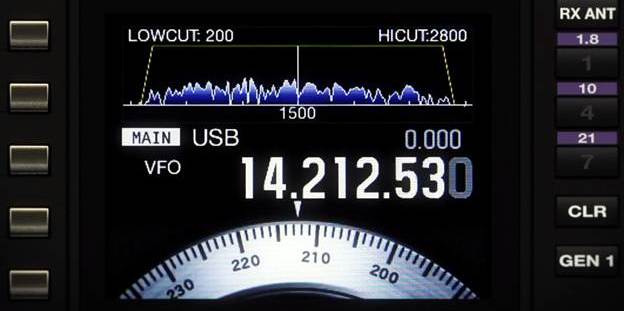
Kenwood TS-990S sub screen: virtual dial with IF passband scope
TS-990S transmitter :
A signal modulated and processed in the DSP is fed as the 24 kHz transmit first IF signal by a D/A converter, and a mixer IC converts it to 10.695 MHz second IF. The signal passes through an filter with a 6 kHz bandwidth at which undesired frequency components outside the band are attenuated, and is then amplified. Next, the signal goes through a gain control circuit that corrects the gain difference by band, enters a TX/RX mixer, and is then converted to the 73.095 MHz third IF signal. After that, the signal passes through a gain control circuit that corrects the signal gain to the required level for the specified transmit power. The signal then passes through a filter that eliminates unwanted spurious components and an ALC circuit that controls the signal to be a stable transmit power, and enters a mixer circuit for conversion to the desired transmit frequency. The signal converted to the desired transmit frequency passes through a band-pass filter to eliminate spurious signals and is amplified to a certain level and sent to the final circuit. The drive signal generated through the process is also available from the DRV terminal.
Transmitter performance, featuring high-scale specifications, can withstand long periods of operation at 200 Watt power. The device uses two VRF150MP power MOSFET, supplied by Microsemi Corporation, in push-pull running at 50 Volt. You can obtain a high, stable full power output on all bands. You can achieve superior IMD properties by pursuing bias and matching conditions in order to fully exploit the FET attributes. Further, you can realize Kenwood's distinctive tone by amplifying the clean modulated signal produced by DSP with an amplifier that exhibits excellent linearity.
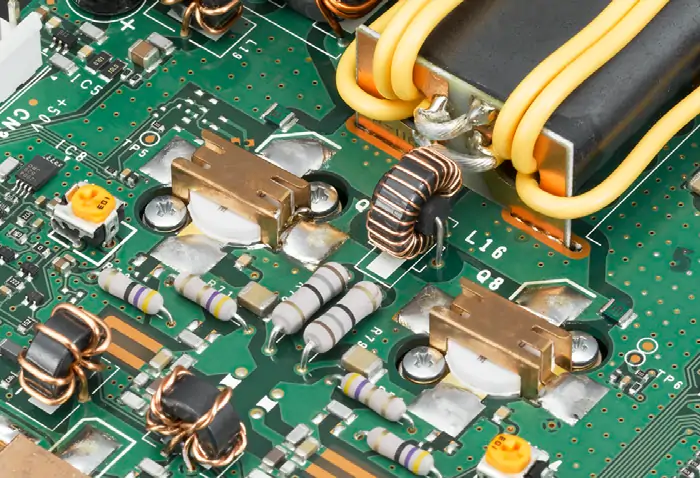
Kenwood TS-990S Final Amplifier
The Kenwood TS‑990S has a high-speed relay-controlled antenna tuner (ATU), which digitally controls in a combination of capacitors of different capacitance through switching relays. The digital control achieves high-speed tuning. The antenna tuner employs parts durable for operating at 200 Watt and has dedicated cooling fans to secure continuous operation at full power. The built-in ATU is a preset type that covers amateur band frequencies ranging from 160 to 6m, and can be switched in on receive too. The tuner is capable of rapid QSY based on instantaneous band change.
TS-990S rear panel and connections :
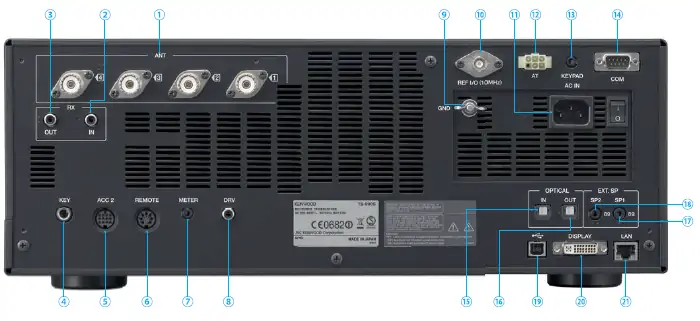
Kenwood TS-990S rear panel and connections
| Reference / Description | |
|---|---|
| 1 | 4 x Antenna Connector. |
| 2 | RX IN, Receive Only Antenna Terminal (RCA). |
| 3 | RX OUT, External Receiver Connection Terminal (RCA). |
| 4 | Key, For Paddle / Straight Key and PC Keying (Jack 6.3 mm). |
| 5 | ACC2, Audio I/O and Other Accessories Connection (13 Pin DIN). |
| 6 | Remote, Linear Amplifier Connection (7 Pin DIN). |
| 7 | Meter, Analogue Meter Connection (Jack 3.5 mm). |
| 8 | DRV, Drive Output (RCA). |
| 9 | Ground Terminal. |
| 10 | Standard I/O 10 MHz (BNC). |
| 11 | AC Power Supply Connector (3 Pin). |
| 12 | AT, External Antenna Tuner Connection (6 Pin). |
| 13 | Keypad, Key Pad Connection (Jack 3.5 mm). |
| 14 | COM, RS-232C (D-SUB 9 Pin). |
| 15 | Input Terminal (EIAJ Optical). |
| 16 | Output Terminal (EIAJ Optical). |
| 17 | External Speaker 1 (Jack 3.5 mm). |
| 18 | External Speaker 2 (Jack 3.5 mm). |
| 19 | USB, PC Control and USB Audio (USB-B). |
| 20 | Display, External Display Connection Terminal (DVI-I). |
| 21 | LAN, PC Control and Time Correction NTP (RJ-45). |
TS-990S photo gallery :

The Kenwood TS-990 with optional SP-990 speaker
TS-990S price
We have collected for your convenience the Kenwood TS990 sale price (US Dollar) and its trend over time. Useful to guarantee a cheaper purchase of this radio and to put it for sale in the second-hand market. Of course offers, accessories, warranty terms and conditions can lead to different figures.
|
|
|
|
| USD 8399.95 | 2023-mar | Brand-new |
| USD 7379.00 | 2021-nov | Brand-new |
|
USD 5485.00 (3999GBP) |
2021-oct |
Second Hand Excellent condition, only one year old |
TS-990S review
Your opinion on merits, defects, experiences, with this radio set is welcome. Write your review, after a technical evaluation by our staff if found suitable will be published on this page. We thank you for your precious contribution.
